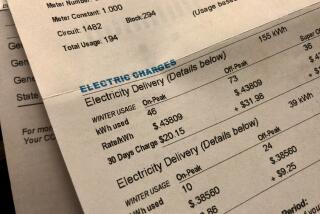Posting a Complaint : Suit Challenges Rate Increase for Third-Class Mail
- Share via
Call it junk mail or call it bulk mail. The price of postage is going up, and those who send out millions of catalogues, advertisements and solicitations every year may soon be paying at least 25% more.
The rise in third-class postage announced this week by the U.S. Postal Service is part of an overall increase in postal rates scheduled to take effect April 3. First-class postage will go up to a quarter.
Already, the nation’s bulk mailers are organizing opposition to the increase, and Thursday they filed a lawsuit to stop it. “Something will have to give, because third-class mailers are really being hit,” said Lisa Caugherty, a spokeswoman for the Direct Marketing Assn.
Among those weighing the new postal rates is the Ventura-based mail-order division of Patagonia, which sells about 15% of its outdoor clothing through catalogues and other mail-oriented marketing.
“We won’t immediately cut back on mailings, but we have to take a serious look at this because it’s a significant increase,” said Shirley Aitchison, marketing manager for the company. “This changes the break-even formula. . . . It will change the industry. It’s sure to decrease the number of (third-class) mailings and the frequency of mailing.”
Others welcome the increased third-class rates with the hope that it may cut down on the amount of mail they get. “Anything that would reduce the amount of junk mail I get would be a plus,” said Henry Bissell, a Los Angeles patent lawyer who added that he opposes any increase in the cost of mailing first-class mail.
The opinions in some households are mixed. Alvin Hammer, a Hollywood resident, said he is disturbed by catalogue mail, although his wife welcomes such material. “If the government is losing money, they have to raise rates,” he said.
“I wouldn’t be upset if the amount of junk mail declined,” said Ruth Commanday of Palos Verdes Estates. “There’s too much of it.”
On the other hand, Commanday says consumers should not be asked to pay more for first-class postage. “Twenty-five cents is too much to pay,” she said, suggesting that an increase discourages personal letters. “As it is, people don’t write often enough.”
The increase in postal rates is needed because the Postal Service, an “expensive and labor-intensive” operation, lost $223 million last year, according to Jeanne O’Neill, a spokeswoman for the service.
Panel Recommended Rates
“We have the cheapest mail service in the industrialized world, and we handle more mail than the rest of the world put together,” O’Neill said. “We think it’s a good service . . . and third-class mail is still a bargain.”
The Postal Service’s board of directors approved the new rates Tuesday and announced that they would become effective April 3.
The 25% increase was based on a recommendation from the Postal Rate Commission, which is independent and not part of the Postal Service. It proposed the increase in first- and third-class postage, as well as an 18% increase in second-class postage, which includes newspapers and magazines, and a 14.7% rise in fourth class or parcel post.
Most of the nation’s mail is first or third class. There were 78.8 billion pieces of first-class mail last year, compared to 59.3 billion pieces of third class. There were about 10.3 billion pieces of second-class mail and about 62 million pieces of fourth class.
First-class mail include letters, business correspondence, some more valuable parcels and flat materials. Newspapers and magazines are commonly delivered on second-class rates. Mail-order catalogues, flyers introducing new products or special sales, brochures and other material offering products and services are often sent by way of third class.
Like the boy in the fable, some members of the Direct Marketing Assn. are concerned that they will not be heeded because they have sounded the alarm before.
Invariably, the association--with about 3,000 members, it’s the country’s largest coalition of direct-mail marketers--has said companies would be hurt by every increase in third-class postal rates. The last third-class increase was in 1985, when rates rose an average of 13%.
Faced with the new round of postal rate increases, the association is again trying to arouse public interest and concern about their plight. Their message: The situation is far more serious this time.
“This is not a case of the boy crying, ‘wolf,’ because the increase is almost double the rise of the last period,” said Caugherty, the association spokeswoman. “It’s much more serious this time.”
For now, the association hopes that the Postal Service will have to delay its increase--at least temporarily. The association and seven other parties Thursday filed suit in U.S. District Court in Washington to prevent the Postal Service from implementing the new rates on April 3.
The suit claims that the parties testified at cost-setting hearings before the Postal Rate Commission with the understanding that rates would be raised no sooner than June 4. “There’s not enough time to adjust to the increase,” Caugherty said.
The suit is just the latest action by direct-mail marketers on the postal rate issue. Some companies with major California-based direct marketing operations are leading the resistance to the impending increases.
For example, Harte-Hanks Communications, a San Antonio-based publishing company with large direct marketing operations in Brea and Garden Grove, is one of the eight companies involved in the suit against the Postal Service.
In addition, Richard Sonheim, the president of the Glendale-based operations of Transo Envelope Co. and a director on the association’s board, said he thinks it is time to make the Postal Service a private, for-profit company with more incentives to cut costs and keep postage rates low.
Sonheim, a member of an association task force on the rate increase, said he expects his revenue to dip 10% this year because of the rate increase. If his prediction is accurate, he said, he might have to lay off as many as 20 of his 120 workers. Most direct marketing companies are reassessing their envelope and printing needs in the wake of the Postal Service’s planned increase, he said.
“It’s not the increase, but the extent of the increase,” said Sonheim. “It’s really about 30%. . . . How would we look if we went to our customers and said we were raising prices by 30%?
“It’s going to take some time for companies to recover and readjust to this. . . . There won’t be as much prospecting for new customers from the mail.”
More to Read
Sign up for Essential California
The most important California stories and recommendations in your inbox every morning.
You may occasionally receive promotional content from the Los Angeles Times.










